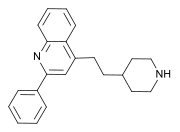Pipequaline
Pipequaline (INN) (developmental code name PK-8165) is an anxiolytic drug that was never marketed.[1] It possesses a novel chemical structure that is not closely related to other drugs of this type. The drug has a similar pharmacological profile to the benzodiazepine family of drugs, but with mainly anxiolytic properties and very little sedative, amnestic or anticonvulsant effects, and so is classified as a nonbenzodiazepine anxiolytic.[2][3][4]
 | |
| Clinical data | |
|---|---|
| ATC code |
|
| Identifiers | |
IUPAC name
| |
| CAS Number | |
| PubChem CID | |
| ChemSpider | |
| UNII | |
| CompTox Dashboard (EPA) | |
| Chemical and physical data | |
| Formula | C22H24N2 |
| Molar mass | 316.439 g/mol g·mol−1 |
| 3D model (JSmol) | |
SMILES
| |
InChI
| |
| | |
Pipequaline acts as a non-selective GABAA receptor partial agonist.[5][6][7] While its profile of anxiolytic effects without sedation would appear to have potential medical applications, pipequaline has never been developed for medical use and is currently only used in scientific research.
References
- J. Elks (14 November 2014). The Dictionary of Drugs: Chemical Data: Chemical Data, Structures and Bibliographies. Springer. pp. 986–. ISBN 978-1-4757-2085-3.
- von Frenckell R, Ansseau M, Bonnet D. Evaluation of the sedative properties of PK 8165 (pipequaline), a benzodiazepine partial agonist, in normal subjects. International Clinical Psychopharmacology. 1986 Jan;1(1):24-35.
- Willer JC, Von Frenkell R, Bonnet D, Le Fur G. The ability of PK 8165, a quinoline derivative, to reduce responses to a stressful situation in a double-blind study in man. Neuropharmacology. 1986 Mar;25(3):275-81.
- Eves FF, Curran HV, Shine P, Lader MH. The effects on memory of pipequaline, alone or in combination with diazepam. Psychopharmacology. 1988;95(3):386-9.
- Mizoule J, Rataud J, Uzan A, Mazadier M, Daniel M, Gauthier A, Ollat C, Gueremy C, Renault C, Dubroeucq MC, et al. Pharmacological evidence that PK 8165 behaves as a partial agonist of brain type benzodiazepine receptors. Archives Internationales de Pharmacodynamie et de Thérapie. 1984 Oct;271(2):189-97.
- Benavides J, Malgouris C, Flamier A, Tur C, Quarteronet D, Begassat F, Camelin JC, Uzan A, Gueremy C, Le Fur G. Biochemical evidence that 2-phenyl-4[(4-piperidinyl) ethyl]quinoline, a quinoline derivative with pure anticonflict properties, is a partial agonist of benzodiazepine receptors. Neuropharmacology. 1984 Oct;23(10):1129-36.
- Debonnel G, de Montigny C. Pipequaline acts as a partial agonist of benzodiazepine receptors: an electrophysiological study in the hippocampus of the rat. Neuropharmacology. 1987 Sep;26(9):1337-42.
This article is issued from
Wikipedia.
The text is licensed under Creative
Commons - Attribution - Sharealike.
Additional terms may apply for the media files.